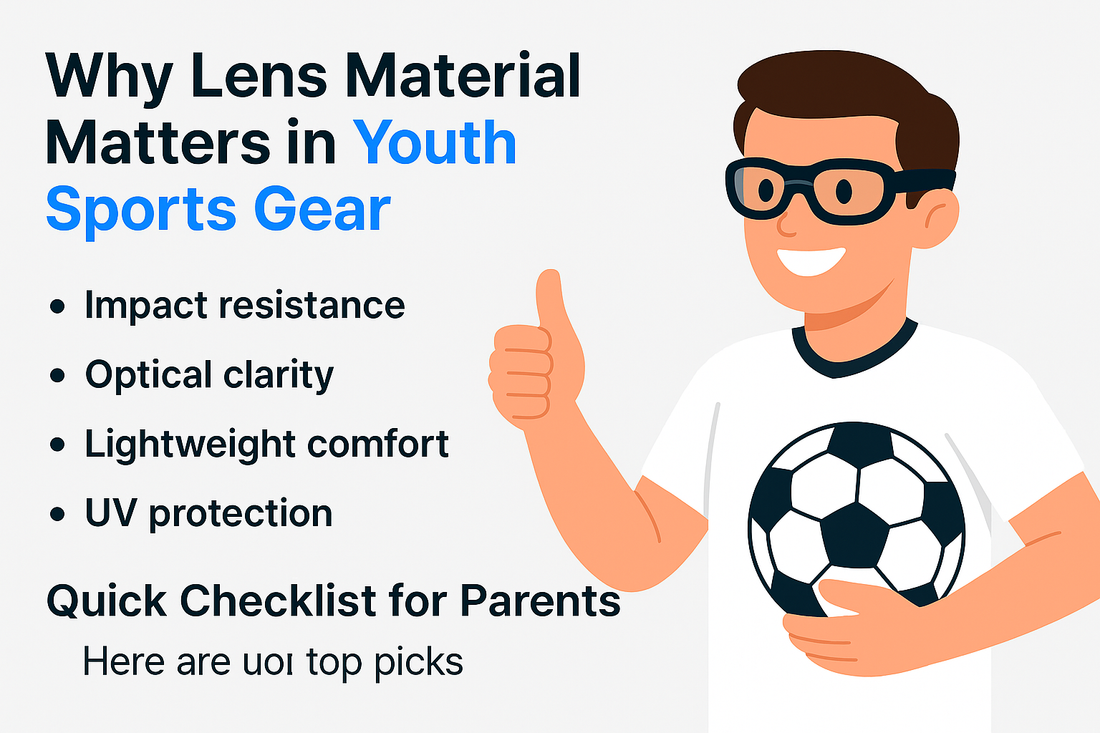
Why Lens Material Matters in Youth Sports Gear
When young athletes sprint, dive, and jump, their eyewear does more than improve vision. The right lens material can protect their eyes, boost confidence, and help them track the action without distractions. Think of lenses as part of their safety gear, not just an accessory. 🛡️
Safety Comes First: Impact Resistance Matters
In sports, balls, elbows, and fast moves can turn into surprise impacts. That is why lens material is crucial. Polycarbonate and Trivex are the top choices for kids because they are highly impact resistant and far less likely to shatter. CR-39 plastic and glass offer good optics but can crack or break, which makes them poor picks for youth sports.
Look for lenses that are thick enough at the edges, sit securely in the frame, and include a sturdy strap if your child plays contact or fast-paced sports like basketball, soccer, or lacrosse. A tough, well-fitted lens is the front line of protection.
Clarity and Focus: Seeing the Play
Clarity is not just about sharpness. It is about consistent vision across the lens so kids can track a ball and read the field. Trivex offers excellent optical clarity with very low distortion, while modern polycarbonate provides highly usable clarity for most young players. The key is quality lens manufacturing and proper fitting so the optical center aligns with your child’s line of sight.
Consider anti-reflective coatings for night games or indoor arenas to reduce glare from lights. For bright outdoor days, tints or light mirror finishes can cut glare and improve contrast without dulling details. ⚽
Lightweight Comfort for Longer Play
Heavy eyewear slips, pinches, and distracts. Polycarbonate and Trivex are both lightweight, which helps frames stay put during sprints and quick changes of direction. Pair lighter lenses with soft, grippy nose pads and a head strap to keep everything stable when the game heats up.
Fogging can also cut into play time. Choose lenses with anti-fog or hydrophilic coatings, and frames with vents or open side channels to promote airflow. Good ventilation plus a snug but not tight fit is the winning combo.
UV Protection Is Non-Negotiable
Kids’ eyes absorb more UV than adults’ eyes, which means full UV protection is essential. Polycarbonate and Trivex naturally block 100 percent of UVA and UVB, so your young athlete gets built-in sun safety with every pair. If your child practices outdoors, consider gray or brown tints for bright sun and amber for overcast conditions. ☀️
Choosing by Sport and Setting
Basketball and indoor court sports: Clear or light amber lenses maximize contrast under artificial lighting. Secure straps help during fast pivots.
Soccer and field sports: Gray or brown tints handle bright sun, while green tints can keep colors true. Light mirror finishes can reduce glare without darkening vision too much.
Baseball and softball: Amber lenses boost contrast to help track the ball against grass and sky. Consider anti-reflective backsides to cut haloing under stadium lights.
Cycling and running: Wrap styles reduce wind and debris. Opt for anti-fog coatings and vented frames for airflow. ✅
Durability and Care
Even the toughest lenses benefit from proper care. Choose scratch-resistant coatings to extend life, then clean with a microfiber cloth and lens-safe spray. Avoid paper products or shirt hems that can grind dust into the surface. Store glasses in a hard case to prevent accidental bumps in the gear bag.
Quick Checklist for Parents
- Impact resistance first: choose polycarbonate or Trivex.
- Full UV protection for outdoor play.
- Lightweight fit with strap and grippy pads.
- Anti-fog and scratch-resistant coatings for longevity.
- Sport-appropriate tints and frame ventilation.
Looking for the right eyewear? Here are our top picks based on today’s article:
Based on today’s topic, here are a few of our top picks you might love:
- Steph Kids Sports Glasses in Black and Blue - Impact-ready lenses and a secure fit for busy game days.
- Winner Kids Sports Glasses in Black - Lightweight comfort with durable protection for all-around play.
- Lebron Kids (White W/Blue Mirror Sunglasses) - UV-blocking coverage and a glare-cutting mirror for sunny fields.
FAQs
How do polycarbonate and Trivex lenses compare for kids?
Both are highly impact resistant and lightweight. Trivex can offer slightly better optical clarity, while polycarbonate is widely available and cost-effective.
What lens color works best for outdoor sports?
Gray or brown for bright sun, amber for overcast or late afternoon. These maintain contrast without distorting colors.
Can my child use regular eyeglasses for sports?
Regular glasses are not designed for impacts. Sports eyewear with impact-resistant lenses and secure frames is the safer choice.
Do prescription lenses reduce protection?
No, as long as the prescription is made in impact-resistant materials like polycarbonate or Trivex and fitted in a sturdy sports frame.
Why do lenses fog, and how can we prevent it?
Heat and sweat meet cooler air, creating condensation. Use anti-fog coatings, choose vented frames, and ensure a balanced, breathable fit.



